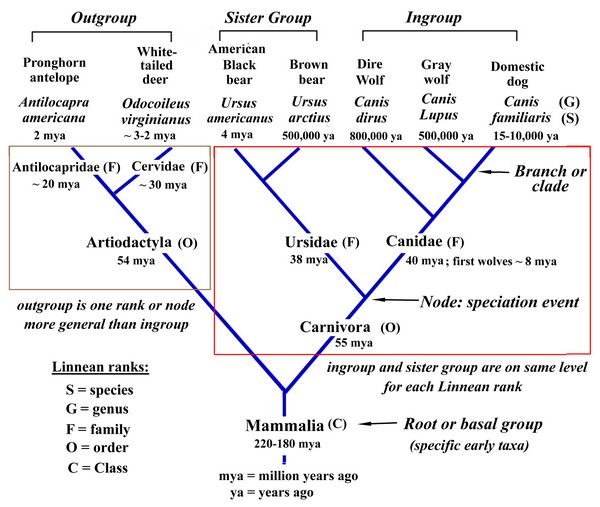Athena Review Image Archive ™
Cladogram of modern mammals

The
cladistic method of classification, called phylogenetic systematics,
was originally designed by the entomologist Willy Hennig (1966) for
classifying insects. It is intended to be used for deciphering and
describing the closest evolutionary relations of species,
both extant and extinct, though the extensive comparison of anatomical
traits called characters. The goal of cladistics is to create
phylogenies, or relationship trees showing presence or absence of
common ancestors between species and groups of species called clades
(Greek for "branches").
Cladistics has its own terminology
which is totally distinct from that of the Linnean system. The
comparative methods used by cladistics involve, first, the selection of
various (sometimes hundreds) of anatomical traits thought to be
diagnostic for the species under consideration, and the listing of
these in tables, for as many species as can be relevantly compared.
These trait tables are then analyzed through computer programs such as
PAUP, which perform complex pattern-grouping and parsimony
analysis to create “nearest neighbor” tree diagrams. These are
considered to reflect the probable closest relations between taxa,
which can then be expressed in cladograms.
The relationship
trees or “cladograms” aim to show clades or branches called "sister
groups" (see figure), of which every member shares a common
ancester, and avoids portraying long term groupings such as classes or
orders. The goal of requiring every member of a clade to share
the same common ancestor (called a “monophyletic” group), however, in
practical terms, requires a constant mode of revisionism by those
writing up these findings. Every time a significant new fossil is
discovered, it may prompt reorganization of the entire “clade” along
with all neighboring branches (Benton 2000). While the revisions
may be radical and improvisational, the digital methodology can be
rather rigid. A seemingly problematic aspect, related to the
standardization sought via using computer grouping methods, is the
dependence on discrete traits which are either present or absent.
Perhaps, as Professor Jennifer Clack suggests (2012), evolution doesn't
always work that way. The graphic representation in cladograms of
direct relations based on multiple evidence of traits or characters,
however, is usually compelling and productive in understanding the
evolutionary links between groups.
References:
Hennig, Willy 1966
Benton 2000
Clack, Jennifer 2012. Gaining Ground
Copyright © 1996-2020 Rust Family Foundation (All Rights Reserved).